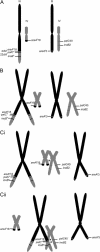Mutational analysis of the pH signal transduction component PalC of Aspergillus nidulans supports distant similarity to BRO1 domain family members
- PMID: 15944343
- PMCID: PMC1456523
- DOI: 10.1534/genetics.105.044644
Mutational analysis of the pH signal transduction component PalC of Aspergillus nidulans supports distant similarity to BRO1 domain family members
Abstract
The alkaline ambient pH signal transduction pathway component PalC has no assigned molecular role. Therefore we attempted a gene-specific mutational analysis and obtained 55 new palC loss-of-function alleles including 24 single residue substitutions. Refined similarity searches reveal conserved PalC regions including one with convincing similarity to the BRO1 domain, denoted PCBROH, where clustering of mutational changes, including PCBROH key residue substitutions, supports its structural and/or functional importance. Since the BRO1 domain occurs in the multivesicular body (MVB) pathway protein Bro1/Vps31 and also the pH signal transduction protein PalA (Rim20), both of which interact with MVB component (ESCRT-III protein) Vps32/Snf7, this might reflect a further link between the pH response and endocytosis.
Figures




Similar articles
-
PalC, one of two Bro1 domain proteins in the fungal pH signalling pathway, localizes to cortical structures and binds Vps32.Traffic. 2007 Oct;8(10):1346-64. doi: 10.1111/j.1600-0854.2007.00620.x. Epub 2007 Aug 13. Traffic. 2007. PMID: 17696968 Free PMC article.
-
Control of Bro1-domain protein Rim20 localization by external pH, ESCRT machinery, and the Saccharomyces cerevisiae Rim101 pathway.Mol Biol Cell. 2006 Mar;17(3):1344-53. doi: 10.1091/mbc.e05-10-0949. Epub 2006 Jan 11. Mol Biol Cell. 2006. PMID: 16407402 Free PMC article.
-
Multivesicular body-ESCRT components function in pH response regulation in Saccharomyces cerevisiae and Candida albicans.Mol Biol Cell. 2004 Dec;15(12):5528-37. doi: 10.1091/mbc.e04-08-0666. Epub 2004 Sep 15. Mol Biol Cell. 2004. PMID: 15371534 Free PMC article.
-
Liaison alcaline: Pals entice non-endosomal ESCRTs to the plasma membrane for pH signaling.Curr Opin Microbiol. 2014 Dec;22:49-59. doi: 10.1016/j.mib.2014.09.005. Curr Opin Microbiol. 2014. PMID: 25460796 Review.
-
The signaling mechanism of ambient pH sensing and adaptation in yeast and fungi.FEBS J. 2012 Apr;279(8):1407-13. doi: 10.1111/j.1742-4658.2012.08548.x. Epub 2012 Mar 23. FEBS J. 2012. PMID: 22360598 Review.
Cited by
-
Further characterization of the signaling proteolysis step in the Aspergillus nidulans pH signal transduction pathway.Eukaryot Cell. 2007 Jun;6(6):960-70. doi: 10.1128/EC.00047-07. Epub 2007 Apr 6. Eukaryot Cell. 2007. PMID: 17416893 Free PMC article.
-
Calpain chronicle--an enzyme family under multidisciplinary characterization.Proc Jpn Acad Ser B Phys Biol Sci. 2011;87(6):287-327. doi: 10.2183/pjab.87.287. Proc Jpn Acad Ser B Phys Biol Sci. 2011. PMID: 21670566 Free PMC article. Review.
-
Mutational analysis of Candida albicans SNF7 reveals genetically separable Rim101 and ESCRT functions and demonstrates divergence in bro1-domain protein interactions.Genetics. 2010 Mar;184(3):673-94. doi: 10.1534/genetics.109.112029. Epub 2009 Dec 21. Genetics. 2010. PMID: 20026677 Free PMC article.
-
In Aspergillus nidulans the suppressors suaA and suaC code for release factors eRF1 and eRF3 and suaD codes for a glutamine tRNA.G3 (Bethesda). 2014 Apr 11;4(6):1047-57. doi: 10.1534/g3.114.010702. G3 (Bethesda). 2014. PMID: 24727290 Free PMC article.
-
PalC, one of two Bro1 domain proteins in the fungal pH signalling pathway, localizes to cortical structures and binds Vps32.Traffic. 2007 Oct;8(10):1346-64. doi: 10.1111/j.1600-0854.2007.00620.x. Epub 2007 Aug 13. Traffic. 2007. PMID: 17696968 Free PMC article.
References
-
- Arst, H. N., Jr., and M. A. Peñalva, 2003. pH regulation in Aspergillus and parallels with higher eukaryotic regulatory systems. Trends Genet. 19: 224–231. - PubMed
-
- Arst, H. N., Jr., D. Tollervey and M. X. Caddick, 1989. A translocation associated, loss-of-function mutation in the nitrogen metabolite repression regulatory gene of Aspergillus nidulans can revert intracistronically. Mol. Gen. Genet. 215: 364–367. - PubMed
-
- Arst, H. N., Jr., E. Bignell and J. Tilburn, 1994. Two new genes involved in signalling ambient pH in Aspergillus nidulans. Mol. Gen. Genet. 245: 787–790. - PubMed
-
- Bignell, E., S. Negrete-Urtasun, A. M. Calcagno, K. Haynes, H. N. Arst, Jr. et al., 2005. The Aspergillus pH-responsive transcription factor PacC regulates virulence. Mol. Microbiol. 55: 1072–1084. - PubMed
Publication types
MeSH terms
Substances
Grants and funding
LinkOut - more resources
Full Text Sources

